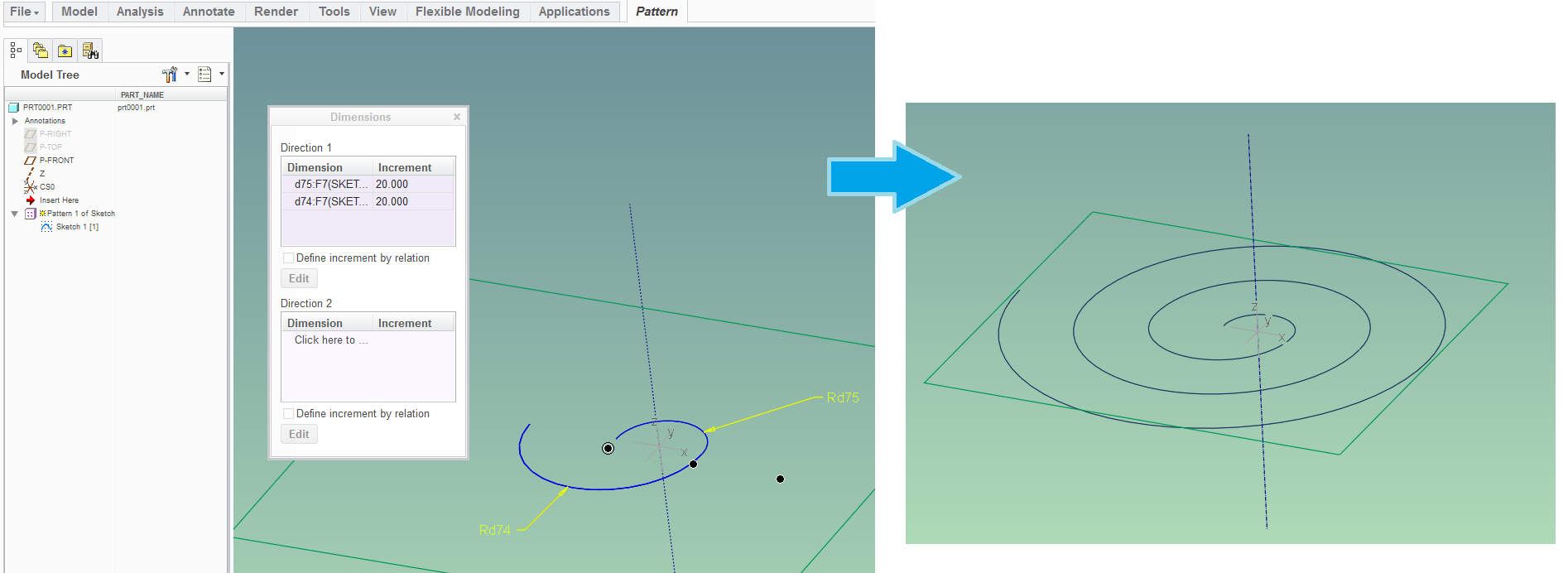Community Tip - Did you know you can set a signature that will be added to all your posts? Set it here! X
- Community
- Creo+ and Creo Parametric
- 3D Part & Assembly Design
- Re: drawing spiral
- Subscribe to RSS Feed
- Mark Topic as New
- Mark Topic as Read
- Float this Topic for Current User
- Bookmark
- Subscribe
- Mute
- Printer Friendly Page
drawing spiral
- Mark as New
- Bookmark
- Subscribe
- Mute
- Subscribe to RSS Feed
- Permalink
- Notify Moderator
drawing spiral
Hi how can I draw these spiral using Relations and Pattern features?
This thread is inactive and closed by the PTC Community Management Team. If you would like to provide a reply and re-open this thread, please notify the moderator and reference the thread. You may also use "Start a topic" button to ask a new question. Please be sure to include what version of the PTC product you are using so another community member knowledgeable about your version may be able to assist.
Solved! Go to Solution.
- Labels:
-
General
Accepted Solutions
- Mark as New
- Bookmark
- Subscribe
- Mute
- Subscribe to RSS Feed
- Permalink
- Notify Moderator
One way is to do a dimension-based pattern a sketch which contains 2 tangent arcs:

Rd75 = 10
Rd74 = 20
Both radii in the sketch are incremented in the pattern definition; so the next instance's smaller arc has the radius as the previous instance's larger arc...
I just sketched this example quickly and it worked out; but I don't know off the top of my head the formula for the increments that achieves the continuous spiral.
- Mark as New
- Bookmark
- Subscribe
- Mute
- Subscribe to RSS Feed
- Permalink
- Notify Moderator
thank you ![]() but how can I draw it using arc and pattern ?
but how can I draw it using arc and pattern ?
- Mark as New
- Bookmark
- Subscribe
- Mute
- Subscribe to RSS Feed
- Permalink
- Notify Moderator
One way is to do a dimension-based pattern a sketch which contains 2 tangent arcs:

Rd75 = 10
Rd74 = 20
Both radii in the sketch are incremented in the pattern definition; so the next instance's smaller arc has the radius as the previous instance's larger arc...
I just sketched this example quickly and it worked out; but I don't know off the top of my head the formula for the increments that achieves the continuous spiral.
- Mark as New
- Bookmark
- Subscribe
- Mute
- Subscribe to RSS Feed
- Permalink
- Notify Moderator
thank you ![]()
.png)
- Mark as New
- Bookmark
- Subscribe
- Mute
- Subscribe to RSS Feed
- Permalink
- Notify Moderator
There is a small problem
.png)
- Mark as New
- Bookmark
- Subscribe
- Mute
- Subscribe to RSS Feed
- Permalink
- Notify Moderator
Part of the problem is a spiral is not defined simply as two circular patterned and incremented as you have done they are specified by equations as Steve shows. You might get close with what you are doing but it's not a true spiral.
- Mark as New
- Bookmark
- Subscribe
- Mute
- Subscribe to RSS Feed
- Permalink
- Notify Moderator
Creating a datum curve by cylindrical equation will create the most accurate spiral.
There is always more to learn in Creo.
- Mark as New
- Bookmark
- Subscribe
- Mute
- Subscribe to RSS Feed
- Permalink
- Notify Moderator
In the 1st sketch, the centers and ends of the 2 connected arcs have to all be co-linear. This means that the arcs are tangent to one another and the tangent line and the two free ends are pointing in the same direction (which is perpendicular to the co-linear line).
Also, to get a continuous "spiral", I think the increment amount in the pattern has to be equal for both radii and its value is 2*(difference in sizes of the radii in the 1st sketch).
- Mark as New
- Bookmark
- Subscribe
- Mute
- Subscribe to RSS Feed
- Permalink
- Notify Moderator
To make a spiral that behaves according to the original post's attached picture, I would create a datum curve by equation with cylindrical coordinates.
Input IR (Inner radius), N (Number of Turns), PITCH (Pitch)
Setup the equation like this:
/* r =IR + t * (N * PITCH) , IR = Starting Radius, N = Number of Turns, t [0-1], (N*PITCH) = OR - IR, OR = Outer Radius
r = IR + t * (N * PITCH)
/* theta = t * N * 360 , theta = angle, t [0-1], N = Number of Turns, 360 = full circle
theta = t * N * 360
/* z = height , 0 = flat, t * cos(r) = helical spiral thingy
z = 0
- Mark as New
- Bookmark
- Subscribe
- Mute
- Subscribe to RSS Feed
- Permalink
- Notify Moderator
Another alternative is by projecting the swept surface edges to a plane:
- Mark as New
- Bookmark
- Subscribe
- Mute
- Subscribe to RSS Feed
- Permalink
- Notify Moderator
Like several other posts have said it wont be a true spiral using relations and pattern features. Why did you want to use these features?
The easiest way to do it is by a cylindrical coordinate equation, as posted earlier. Is there a reason you can't or don't want to use that?


